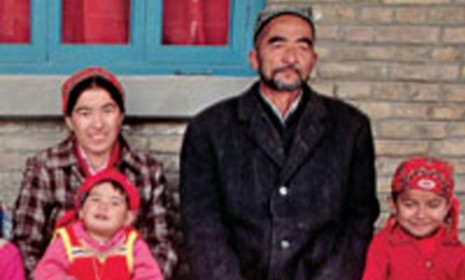The plight of the Uighurs
A remote, little-known people are at the center of China’s worst ethnic violence in decades.

What’s behind the recent unrest?
A concerted campaign by Beijing to assert control over a restive region that for centuries was dominated by the Uighurs (pronounced WEE-gurs), Turkic-speaking Muslims who migrated from Mongolia. Since the 10th century, the Uighurs have lived in and around the Tarim Basin, a vast, mountain-bound depression in northwest China bordering Tibet. The region’s rugged, arid terrain is so inhospitable that it was one of the last areas on earth to be settled. Historically, the Uighurs were money-changers and merchants who operated along the Silk Road, the legendary trading route between Asia and Europe. But today, most of them—about 10 million—live a harsh, uncertain existence in what is now Xinjiang, about 2,000 miles from Beijing. Last month, China’s worst unrest since the 1989 Tiananmen Square massacre left some 200 people in Xinjiang dead and more than 1,000 injured. The killings were the latest result of longstanding ethnic tensions between the Uighurs and the Han, the ethnic group that makes up 92 percent of China’s population.
What happened?
The Week
Escape your echo chamber. Get the facts behind the news, plus analysis from multiple perspectives.

Sign up for The Week's Free Newsletters
From our morning news briefing to a weekly Good News Newsletter, get the best of The Week delivered directly to your inbox.
From our morning news briefing to a weekly Good News Newsletter, get the best of The Week delivered directly to your inbox.
The trouble began in late June, when a false rumor that Uighur men had raped some Han women sparked a melee involving hundreds of Han and Uighurs, who attacked each other with knives and metal pipes. Two Uighurs died. In response, several hundred Uighurs gathered for a protest march in Xinjiang’s capital city of Urumqi, during which Uighurs torched cars and shattered store windows with stones. Thousands of Han fought back with hammers, baseball bats, and pool cues, yelling, “Kill the Uighurs! Kill all Uighurs!” There were reports of police standing by while Uighurs were savagely beaten, and many bodies were burned beyond recognition. Police eventually brought the riot under control, but the situation remains tense.
Why are Uighurs under assault?
Beijing wants the Han to control the political and economic levers of Xinjiang, which boasts rich mineral, gas, and oil deposits. Toward that end, Beijing has been systematically crushing Uighur culture—banning the language from schools, forbidding Uighurs from wearing beards and head scarves, and razing large sections of their cities to make way for modern developments. Beijing has also been resettling millions of Han in Xinjiang while moving Uighurs to other areas throughout China—where, the government says, they have better opportunities. Only the Han in Xinjiang receive government perks such as health insurance, housing, and free transportation. Within a few hundred yards of the steel-and-glass towers where many Han live and work, Uighurs dwell in mud-brick homes without running water or sewers. “We all feel the difference,” said Ashan Saidi, who recently lost his job as a street cleaner. “There are seven people in my family. We want to buy an apartment, but we can’t afford it.”
When did this conflict start?
A free daily email with the biggest news stories of the day – and the best features from TheWeek.com
Its roots extend back to about 1760 in the Qing Dynasty, when China annexed Xinjiang. There were periodic conflicts over the next two centuries, but the region was largely left alone because it was so remote. In 1944, the Uighurs declared Xinjiang’s independence, renaming it East Turkestan—a name that Uighurs still use. But when Mao Tse-tung’s Communists took power in 1949, they regained control of Xinjiang and began resettling large numbers of soldiers there. A second wave of repression occurred in the 1990s, following the breakup of the Soviet Union. Fearful that Xinjiang might get separatist notions of its own, Beijing began labeling Uighurs traitors and terrorists. Violence has flared every few years since then, with the central government cracking down hard.
Are the Uighurs separatists?
Some of them are. Whenever blood is spilled in Xinjiang, the state-run media usually pins the blame on what it depicts as sinister forces bent on insurrection. Their favorite target is the World Uighur Congress, an umbrella group of expatriates. There’s also the East Turkestan Islamic Movement, which wants to create an independent Islamic state of East Turkestan. The ETIM reportedly has links to al Qaida and has been labeled a terrorist group by both Beijing and Washington. Many Uighurs, though, simply want to be left alone, free to practice their religion and maintain their way of life in their own homeland.
Is that likely?
No. The Uighurs’ future appears grim. Unlike the Buddhist Tibetans, the Uighurs have yet to command the world’s sympathy, in part because they lack a charismatic, globe-trotting, multilingual leader like the Dalai Lama. Some Muslim nations are protesting China’s treatment of the Uighurs—Prime Minister Recep Tayyip Erdogan of Turkey has called it “a kind of genocide”—but the Western response has been muted. President Obama urged both sides in Xinjiang “to exercise restraint,” while the European Union declared that the Urumqi massacre was “a Chinese issue, not a European issue.” World Uighur Congress President Rebiya Kadeer, who now lives in Virginia, has been trying to generate support for her people. “Only if the world pays the same attention to Uighurs as to Tibet and Darfur,” she said through a translator, “is there a chance for this to change.”
The Uighurs of Guantánamo
Most Americans had never heard of Uighurs until earlier this year, when a small group of them became embroiled in a drama at the U.S. military prison at Guantánamo Bay. The saga of the Guantánamo Uighurs actually began soon after the U.S. invasion of Afghanistan, in 2001, when Pakistani bounty hunters turned over 22 Uighurs to the U.S. The Uighurs claimed they were in Afghanistan to receive military training in the fight for their people’s “liberation,” not to fight Americans. After keeping them in Guantánamo for years, the Bush administration determined they were neither enemy combatants nor security risks and, in 2006, released five to Albania. A federal judge ordered that the remaining 17 be freed, and in June the Obama administration released four more to Bermuda. The fate of the remaining 13 remains unclear. Congress voted overwhelmingly to prohibit any Guantánamo detainees from being resettled in the U.S., and most countries don’t want them out of fear of offending China. The Pacific island of Palau recently said it would take the Uighurs, though no formal offer has been made. The U.S. has promised Palau an additional $200 million in development aid.
-
 How the War Department became the Department of Defense – and back again
How the War Department became the Department of Defense – and back againIn Depth In 1947 President Harry Truman restructured the US military establishment, breaking with naming tradition
-
 Codeword: December 8, 2025
Codeword: December 8, 2025The daily codeword puzzle from The Week
-
 Sudoku medium: December 8, 2025
Sudoku medium: December 8, 2025The daily medium sudoku puzzle from The Week